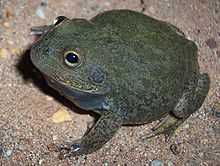Litoria platycephala
| Litoria platycephala | |
|---|---|
 | |
| [1] | |
| Conservation status | |
| Scientific classification | |
| Kingdom: | Animalia |
| Phylum: | Chordata |
| Class: | Amphibia |
| Order: | Anura |
| Family: | Hylidae |
| Genus: | Cyclorana |
| Species: | C. platycephala |
| Binomial name | |
| Cyclorana platycephala Günther, 1873 | |
Cyclorana platycephala (formerly Litoria platycephala), the water-holding frog, is a frog common to most Australian states. It differs from most other members of the Hylidae family as a ground dweller and the ability to aestivate.
Description
The species has populations spread across all the Australian states except Victoria and Tasmania.[1] It occupies a wide range of habitat from forests of tropical swamp to intermittent pools and lowland grass country; all habitat is assumed to be of a low elevation. Populations are assumed to be large from frequent reports and a broad range.[1] This range is assumed to overlap with National parks, but research has not been undertaken into the ecology and biology of the species.[2] It buries itself in sandy ground in a secreted, water-tight, mucus cocoon with its external skin during periods of hot, dry weather. For additional nutrition and to save energy, the frog eats the external skin.[3] It has been known to burrow to depths of up to 1 meter.[4]
The water-holding frog is characterized by a broad, flat head, completely webbed toes, and a stout body which is usually dull gray to dark brown or green. They also have small eyes that are placed somewhat laterally and forward-directed, enhancing vision downward and binocular perspective (Cogger and Zweifel 1998)[5]
Reproduction
The water-holding frog only emerges from deep underground after it rains to breed. It lays large amounts of spawn in still water after floods. Some eggs may be attached to vegetation, or spread in a thin film on the surface, thus ensuring adequate oxygen in warm waters suffering from oxygen depletion (Cogger and Zweifel 1998). Tadpoles of the water-holding frog can reach a maximum length of 60mm (S. Australian Frogcensus 1999).[6]
Human interaction
Australian Aborigines discovered a means to take advantage of this ability by digging up one of these frogs and gently squeezing it, causing the frog to release some of the fresh water it stores for itself in its bladder and skin pockets. This water can be consumed by the Aborigine, who then releases the frog.[7] [8]
Threatened status
No threats have been identified, research into the extent of habitat loss through land clearing and the associated salinity is yet to be undertaken. The species is given Least Concern status at the IUCN Red List [Red List link] due to a wide range and large population.
Further reading
- Cogger, H.G. 2000. Reptiles and Amphibians of Australia, Sixth Edition. Reed New Holland, New South Wales.
- [9]
References
- ↑ 1.0 1.1 1.2 Jean-Marc Hero, John Clarke, Ed Meyer, Richard Retallick, Paul Horner, Dale Roberts (2004). "Litoria platycephala". IUCN Red List of Threatened Species. Version 2009.2. International Union for Conservation of Nature. Retrieved 24 February 2010.
- ↑ Hero, Jean-Marc. "Litoria platycephala". Litoria platycephala. IUCN 2013. Retrieved 25 September 2013.
- ↑ "Litoria platycephala — Details Water-holding Frog". Retrieved 25 September 2013.
- ↑ Tyler, M.J., Slack-Smith, Shirley (2012). Field Guide to Frogs of Western Australia. Perth: Western Australia Museum. p. 164. ISBN 9781920843915.
- ↑ "Encyclopedia of Reptiles and Amphibians: A Comprehensive Illustrated Guide by International Experts.".
- ↑ http://animaldiversity.ummz.umich.edu/accounts/Litoria_platycephala/. Retrieved 26 september 2013. Missing or empty
|title=(help) - ↑ Kierzek, Megan. "Litoria platycephala". Animal Diversity Web. Retrieved 25 September 2013.
- ↑ Vanderduys (2012). Field guide to the frogs of queensland. Melbourne: CSIRO PUBLISHING.
- ↑ "Litoria platycephala". Retrieved 25 September 2013.
- Hero, J M; et al. (2002-04-05). "Cyclorana platycephala Water-holding Frog". AmphibiaWeb. Berkeley (The Regents of the University of California). Retrieved 2007-04-07. "There are three separate populations. One in the central arid zone of Western Australia from Winning Pool east to Lake Disappointment and south to Morawa and Laverton. There is a small area in the north-western corner of the Northern Territory. Another large area extends from northern South Australia into New South Wales and south-western Queensland. The extent of occurrence of the species is approximately 1645500 km². Widely dispersed in habitat."
